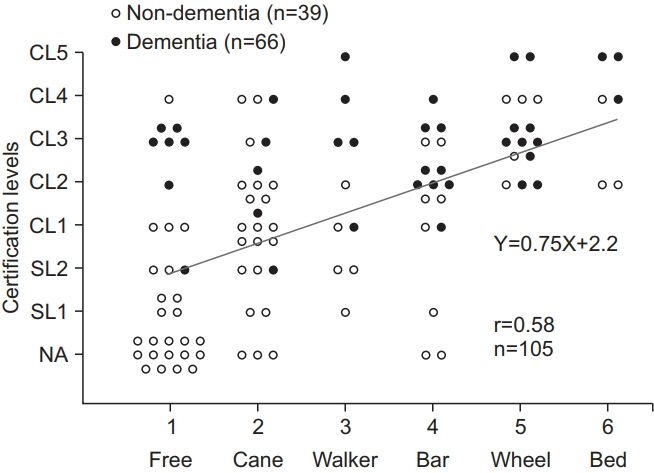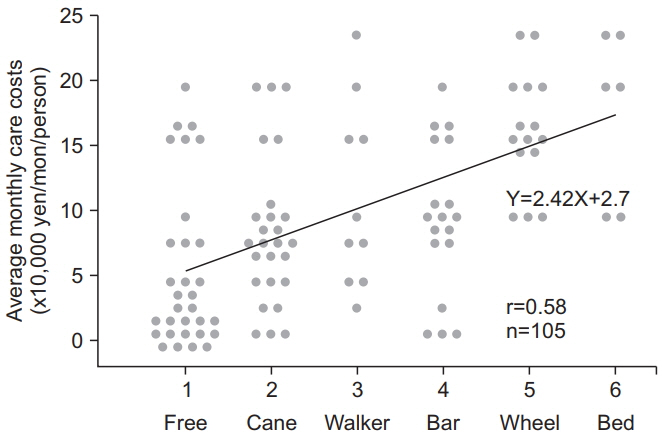Ann Rehabil Med.
2018 Aug;42(4):569-574. 10.5535/arm.2018.42.4.569.
Correlation Between Walking Ability and Monthly Care Costs in Elderly Patients After Surgical Treatments for Hip Fractures
- Affiliations
-
- 1Department of Orthopedic Surgery, Graduate School of Medicine, Chiba University, Chiba City, Chiba, Japan. abeabeabe04@yahoo.co.jp
- 2Department of Orthopedic Surgery, JCHO Funabashi Central Hospital, Funabashi City, Chiba, Japan.
- 3Nakata Orthopedics Clinic, Funabashi City, Chiba, Japan.
- 4Mitsuka Rheumatism Clinic, Narashino City, Chiba, Japan.
- 5Takanecho Orthopedics Clinic, Chiba City, Chiba, Japan.
- 6National Hospital Organization Shimoshizu Hospital, Yotsukaido City, Chiba, Japan.
- KMID: 2420049
- DOI: http://doi.org/10.5535/arm.2018.42.4.569
Abstract
OBJECTIVE
To validate the relationship between residual walking ability and monthly care cost as well as long-term care insurance (LTCI) certification level in elderly patients after surgical treatment for hip fractures in Japan.
METHODS
Elderly patients aged >75 years who underwent surgical treatment for hip fractures in our hospital were included. The preand post-surgical (6-month) walking ability and LTCI certification and the presence or absence of dementia was determined from medical records and questionnaires. Walking ability was classified into 6 levels used in our daily medical practice. Based on these data, we correlated the relationship between walking ability and the LTCI certification level. Further, based on the official statistics pertaining to the average monthly costs per person at each LTCI certification level, we evaluated the relationship between walking ability and monthly care cost.
RESULTS
A total of 105 cases (mean age, 80.2 years; 16 men; 39 patients with dementia) were included. The correlation between walking ability and average monthly cost per person as well as LTCI certification level at 6 months postoperatively (r=0.58) was demonstrated. The correlation was found in both groups with and without dementia.
CONCLUSION
The ability to walk reduced the cost of care in elderly patients who experienced hip fracture, regardless of the presence of dementia.
MeSH Terms
Figure
Reference
-
1. Yamauchi Y. Decomposing cost efficiency in regional long-term care provision in Japan. Glob J Health Sci. 2015; 8:89–100.
Article2. Tsutsui T, Muramatsu N. Care-needs certification in the long-term care insurance system of Japan. J Am Geriatr Soc. 2005; 53:522–7.
Article3. Health, Labour and Welfare Statistics Association. Survey of long-term care benefit expenditures, FY2013, summary of annual report. J Health Welfare Stat. 2014; 61:51–7.4. Hagino H, Sakamoto K, Harada A, Nakamura T, Mutoh Y, Mori S, et al. Nationwide one-decade survey of hip fractures in Japan. J Orthop Sci. 2010; 15:737–45.
Article5. Takamine B, Morii T, Watanabe H, Tajima T, Satomi K. Short-term postoperative mortality events in patients over 80 years of age with hip fracture: analysis at a single institution with limited medical resources. J Orthop Sci. 2010; 15:437–42.
Article6. Kim YH, Kwon CH, Shin HI. Validity of motor impairment scale in long-term care insurance system of Korea. Ann Rehabil Med. 2013; 37:403–12.
Article7. Njegovan V, Hing MM, Mitchell SL, Molnar FJ. The hierarchy of functional loss associated with cognitive decline in older persons. J Gerontol A Biol Sci Med Sci. 2001; 56:M638–43.
Article8. Iwasa H, Gondo Y, Yoshida Y, Kwon J, Inagaki H, Kawaai C, et al. Cognitive performance as a predictor of functional decline among the non-disabled elderly dwelling in a Japanese community: a 4-year population-based prospective cohort study. Arch Gerontol Geriatr. 2008; 47:139–49.
Article9. Miyanishi K, Jingushi S, Torisu T. Mortality after hip fracture in Japan: the role of nutritional status. J Orthop Surg (Hong Kong). 2010; 18:265–70.
Article10. Takayama S, Iki M, Kusaka Y, Takagi H, Tamaki S. Rate of mortality with hip fracture and its prognostic factors in an elderly Japanese population. Environ Health Prev Med. 2001; 5:160–6.
Article11. Tsuboi M, Hasegawa Y, Suzuki S, Wingstrand H, Thorngren KG. Mortality and mobility after hip fracture in Japan: a ten-year follow-up. J Bone Joint Surg Br. 2007; 89:461–6.
- Full Text Links
- Actions
-
Cited
- CITED
-
- Close
- Share
- Similar articles
-
- The Analysis of Postoperative Mortality after Bipolar Hemiarthroplasty for Hip Fractures in the Elderly
- Hemiarthroplasty for Hip Fractures in Elderly Patients over 80 Years Old - Comparative Analysis between Femoral Neck Fracture and Intertrochanteric Fracture -
- Morbidity and Mortality of Bilateral Hip Fractures in Elderly Patients
- Bipolar Hemiarthroplasty Using Calcar Replacement Stem for Hip Fractures in the Elderly
- The Treatment of the Hip fracture in the Dementia Patients




